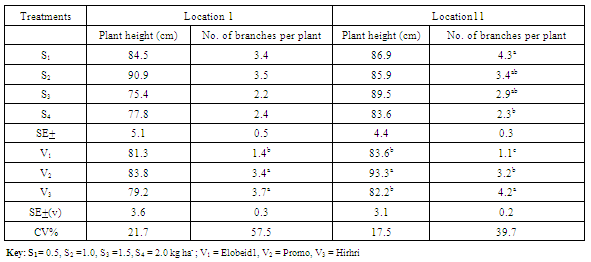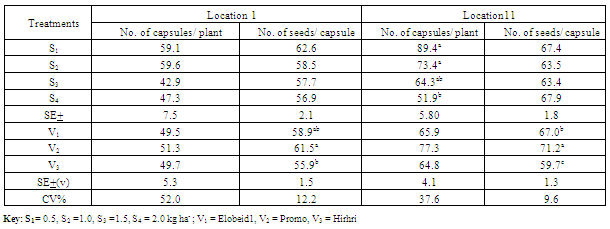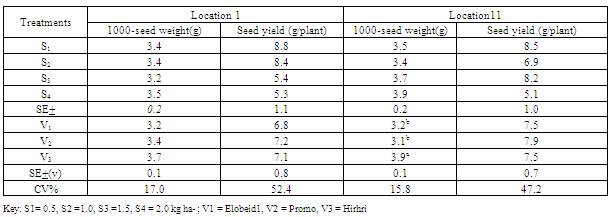| [1] | El Naim, A. M., El day, E. M. and Ahmed, A. A. Effect of plant density on the performance of some sesame (Sesamum indicum L) cultivars under Rain -fed. Research Journal of Agriculture and Biological Sciences, 6(4): 498-504, 2010 |
| [2] | Lazim, M.E. Population and cultivar effects on growth and yield of sesame under irrigation. M.Sc. Thesis, Faculty of Agricultural, University of Khartoum, 1973 |
| [3] | Omran, A. Oil crops network for East Africa and India region. In:sesame and safflower:status and potentials. FAO Plant Production and Protection paper 66:pp. 52-58, 1985 |
| [4] | El Naim, A. M., Hagelsheep, A. M., Abdelmuhsin, M. E. and Abdalla, A. E. Effect of Intra-row spacing on growth and yield of three cowpea (Vigna unguiculataL. Walp.) Varieties under rainfed. Research Journal of Agriculture and Biological Sciences, 6(5): 623-629, 2010. |
| [5] | Van Rheenen, H.A. Major problems of growing sesame (Sesamum indicum L.) in Nigeria. Wageningen. Netherland, 73: (12)130, 1973 |
| [6] | Khidir, M.O. Oil Seed Crops in the Sudan. Khartoum University Press, Khartoum, Sudan, 1997. |
| [7] | Osman, H.E. Sesame growing in the Sudan. In sesame and safflower Status and potentials. FAO plant Production and Protection paper 66: pp. 48-51, 1985. |
| [8] | El Naim, A. M. and Ahmed, S. E. Effect of weeding frequencies on growth and yield of two roselle (Hibiscus sabdariffaL) Varieties under rain-fed. Australian Journal of Basic and Applied Sciences, 4(9): 4250-4255, 2010. |
| [9] | Gomez, K.A. and A.A., Gomez. Randomized complete block design analysis. In:statistical procedures for Agricultural Research. John Willy and Sons, Nawyork, 1984. |
| [10] | Ahmed, M.A. A note on performance of two sesame (Sesamum indicum L.) genotypes suggested for releases. Yield stability of sesame in the central rain lands of Sudan. A paper submitted to the variety release committee, Kenana Res. Station, 1998. |
| [11] | El Naim, A.M. Effect of different irrigation water quantities and cultivars on growth and yield of sesame (Sesamum indicum L.). Ph.D.Thesis, Faculty. of Agricultural., University of Khartoum, 2003. |
| [12] | Levy, A., D.,Palevitch and kleifeld, J. Evaluation of eseame cultivars and cultural practice in Israel. In: FAO Plant Production and Protection sesame Technical paper No. 66,107-114, 1985. |
| [13] | Kandasamy, G., Balasubara manian, T.N. and Thangavelu, S. Study on the varietal and spacing interaction in sesame. Sesame and Safflower News letter, 6:41-43 Khatab, A.H. and M.O., Khidir, 1970. Oil and protein content of local sesame types. Journal of food science and Technology (Sudan), 2:8-10, 1991. |
| [14] | Allam, A.Y. Effect of gypsum, nitrogen fertilization and hill spacing on seed and oil yields of sesame cultivated on sandy soil. Agron. Dept., Fac.of Agric. Assiut University, Assiut, Egypt. Assiut Journal of Agricultural Sciences, 33: 4, 1-16, 2002. |
| [15] | Quayyum, S.M., M.A., Rajput, A.H., Ansari and G.M., Umarani. Effect of different inter and intra-row spacing on various agronomic traits in sesame (Sesamum indicum L.). sesame and safflower News letter, 5:23- 28, 1990 |
| [16] | Weiss, E.A. Castor, sesame and safflower, Leonard Hill, London, 1971. |
| [17] | El Naim, A. M. , Eldouma, M, A., Abdalla, A. E. Effect of Weeding Frequencies and Plant Population on Vegetative Growth Characteristic in Groundnut (Arachis hypogaea L.) in North Kordofan of Sudan. International Journal of Applied Biology and Pharmaceutical Technology, 1(3): 1188-1193, 2010 |
| [18] | El Naim, A. M. and Jabereldar, A. A. Effect of Plant density and cultivar on growth and yield of cowpea (Vigna unguiculata L.Walp). Australian Journal of Basic and Applied Sciences, 4(8): 3148-3153, 2010 |
| [19] | El Naim, A. M., Jabereldar, A. A. And Mohammed, E. A. Effect of Seed Rate and Cultivar on Yield and Yield Compononents of Cowpea (Vigna unguiculata L, Walp) in Kordofan of Sudan. International Journal of Current Research. 2(1): 142-147, 2011. |
| [20] | El Naim, A. M; Eldouma, M A; Ibrahim E A; Moayad, M. B. Z. Influence of Plant Spacing and Weeds on Growth and Yield of Peanut (Arachis hypogaea L) in Rain-fed of Sudan. Advances in life Sciences, 1(2): 45-48, 2011 |
| [21] | Narayanan, A. and Narayan, V. Yield responses of sesame cultivars to growing season and population. Journal of Oil Seeds Research, 4(2):193-201, 1987 |
| [22] | Ali, N. Sesamum Research in Pakistan. In: sesame and safflower status and potentials. FAO Plant Production and Protection paper, No.66,34-36, 1985 |
| [23] | Imayavaramban,V., R. Singaravel, K. Thanunathan. and G. Manickam. Studies on the effect of different plant densities of sesame. Department of Agronomy, Annamalai University, Annamalai Nagar (Tamil Nadu), India-Crop.Research-Hisar, 24:2,314-316, 2002 |
| [24] | El Naim A, M. and Ahmed, M. F. Effect of Irrigation Intervals and Intra- row Spacing on Yield, Yields Components and Water Use Efficiency of Sunflower Helianthus annuus L.). Journal of Applied Science Research. 6(9): 1446-1451, 2010 |
| [25] | El Naim, A M; Jabereldar, A. A; Ahmed, S I, Ismaeil, F. M. Ibrahim E A. Determination of suitable variety and plants per stand of cowpea (Vigna unguiculata L, Walp) in sandy soil, Sudan. Advances in life Sciences, 2(1): 1-5, 2012 |
| [26] | Ahmed, R., T. Mahmoud, M.F., Saleemand, S. Ahmed. Comparative Performance of Two Sesame (Sesamum indicum L.) Cultivars under Different Row Spasing. Department of Agronomy, University of Agricultural, Faisalabad, Pakistan.Asian Journal of Plant Sciences. Vol.1 Number, 5:546-547, 2005 |
| [27] | El Nadi, A.H. and Lazim, M. H. Growth and Yield of irrigated sesame.2. Effect of population and variety on reproductive growth and seed yield. Experimental Agriculture, 10:71-76, 1974 |
| [28] | Green, C.F., He bblethwaite, P.D. and Ricketts and H. E. The price of irrigation faba beans. Fabis News letter, 15:26-31, 1986. |

 Harvest index 1s a ratio of economical yield (seed yield per plant to biological yield (shoot dry weight), was determined by using the fallowing formula:-
Harvest index 1s a ratio of economical yield (seed yield per plant to biological yield (shoot dry weight), was determined by using the fallowing formula:-
 Abstract
Abstract Reference
Reference Full-Text PDF
Full-Text PDF Full-Text HTML
Full-Text HTML



